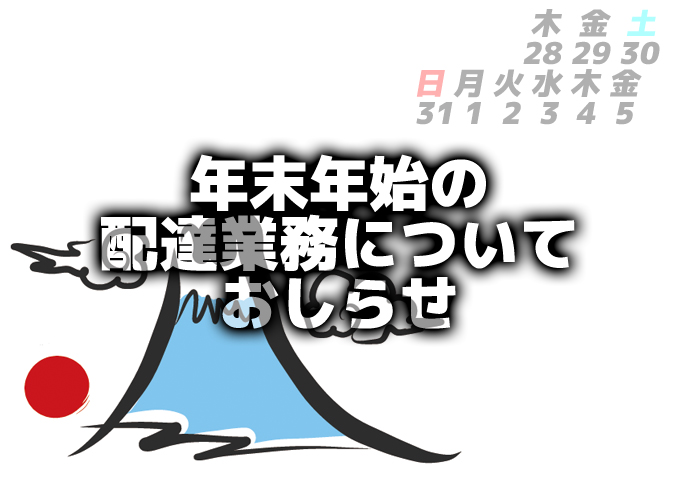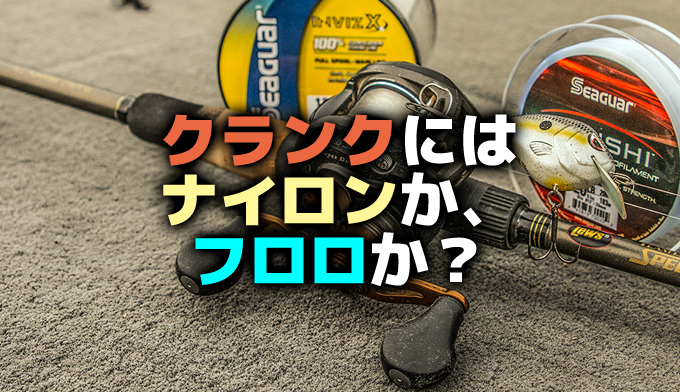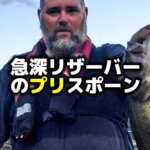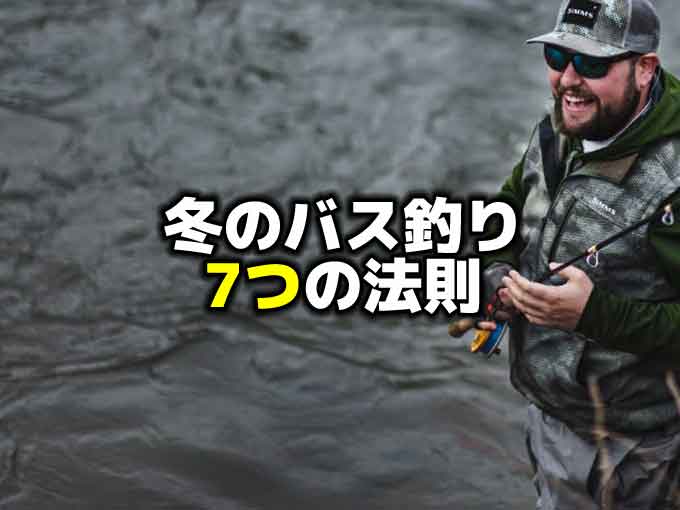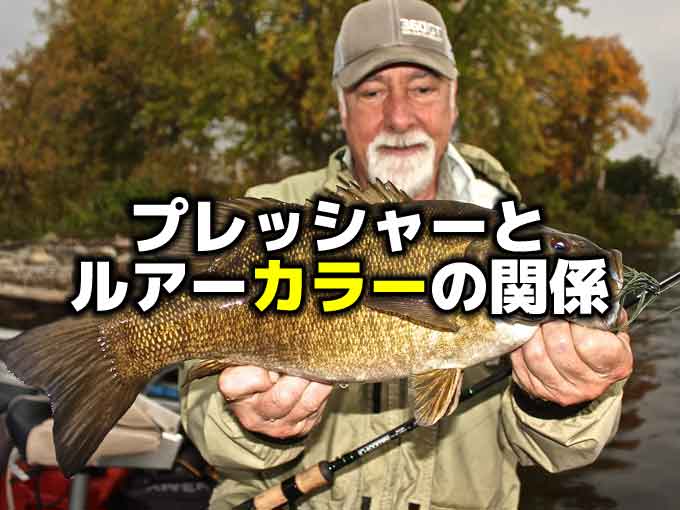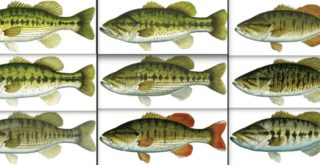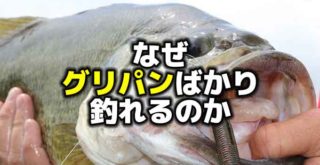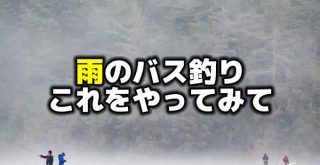冬に狙うべき3つのスポット
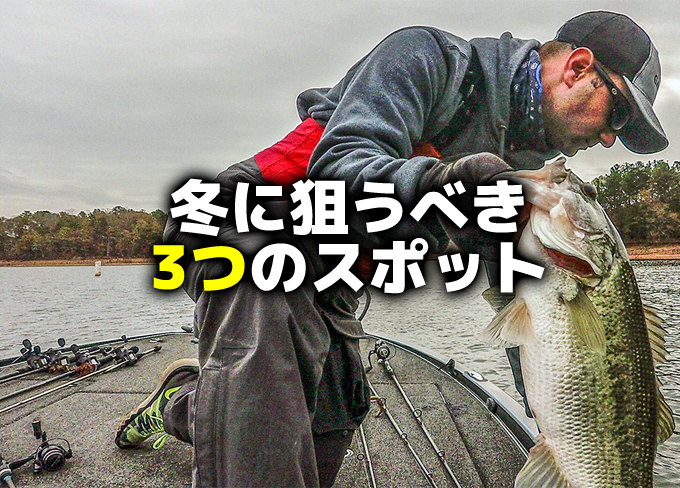
Photo by scout.com
こんにちは!店長の小山です!
本日は海外サイトより、”3 Must-Try Hotspots for Coldwater Bass”という記事を引用してご紹介いたします。
引用先:scout.com”3 Must-Try Hotspots for Coldwater Bass”By Luke Stoner 4.11.2017(海外サイトです)
どの季節にも言えることなのですが、ボートでバスを釣ろうとしたときには、その季節に合ったポイントへ向かう必要がありますよね。
まずは魚がいる場所、願わくば、やる気のある魚だけがウヨウヨいる場所へ行きたいものです。
そういう願いがあるものですから、冬というのは厄介なんですよね。
春から秋にかけては、まず人間側が調子いいんです。快適なんです。そしてバスも見えたりしますし、バイトもありますし、そうするともっと釣る方法まで見えてきたりするものですが、冬はそうはいきません。
まず寒いです。水に落ちたときの危険さは春夏秋の比じゃありませんので、人間側が萎縮してしまいます。そして冬の気温は変温動物全体の活動レベルを下げますから、バスのフィーディングタイムも短くなりますし、フィーディングゾーンも狭くなってしまいます。
私の典型的な冬のパターンは、まず見えバスがいない…どこにいるかもわからない…魚探掛けをがんばる…でもせっかく魚探にバスっぽいのが映ったとしても釣れない…どんどん心が折れてくる…という感じです(笑)
普通だったら、これでは冬に釣りに行けと言われても行けなくなってしまうというもの。
せめて確信を持って釣りができる冬のホットスポットを見つけられたら、ボートも少ない冬ですから、誰にも知られずにウハウハな釣りができる気がするのですが…
この記事は、アメリカのフィッシングメディア、「Wired2Fish」の記者ルーク・ストーナーが、バスプロであるマット・リー氏に取材したことを共有しています。
リー氏が言うには、冬のデッドウォーター(釣る価値のない魚のいない場所)を消去法的に排除していくと、特定の地形変化がカギを握っていることがわかったそうです。
そして冬のバスは集団でかたまっていることが多いため、もしバスを見つけたら同じような地形を探せばもっと多くのバスを見つけることができ、チャンスは広がると言います。
これはぜひ覚えて、冬の釣りのモチベーションアップにつなげたいところです。早速読んでみましょう。
チャンネルスイングバンク
“As water temperatures become cooler and winter settles in, you want to narrow your search down to areas with good depth,” Lee said. “Now ‘good depth’ is going to be different depending on what kind of fishery you’re on and the water color you’re experiencing. But first things first, a bass in cold water wants to be around deep water; somewhere they can move both horizontal and vertically.”
Whether it’s Lake Guntersville or Sam Rayburn, channel swing banks are tried and true locations that Lee keys in on to find relatively deep water in close proximity to shallow cover. Instead of fishing through long stretches of shoreline, Lee focuses where a river or creek channel tucks up to the bank.
“Anytime I see contour lines bunched up tightly against a bank on my electronics I know it’s a place worth fishing in the winter,” Lee explained. “The Garmin electronics I run have ‘depth shading’ which shows each depth zone in a contrasting color, which makes it extremely easy to pick out opportune areas. Even without this feature, channel swing banks are easy to distinguish on most lakes by looking at a contour map.”
These channel swing banks give bass the ability to sit in shallow or deep water in close proximity to one another. These banks are often littered with natural rock, boulders, laydowns and stumps. This gives bass excellent ambush points for prey while providing anglers specific, easy-to-locate targets.
「冬が近づき、水温が低くなるにつれ、適切な深さのディープエリアに絞ってバスを探したいです。適切な「レンジ」とは、釣りをするフィールドの種類や水質によって異なります。しかしまず重要なのは、水が冷たいときバスはディープエリアの周りにいたいということです。そこならタテとヨコ、両方の向きで動くことができるからです。」
ガンターズビルレイクやサムレイバーンのような浅い湖であっても、チャンネルスイングバンクはシャローカバーのすぐ近くに比較的深いエリアを見つけるためにリー氏がキーとする場所です。リーは、長いショアラインをひたすら釣るのではなく、川や支流のチャンネルがどこに集まっているのかを重視しています。
「魚探の等深線を見てブレイクがバンクにぴったりとくっついているのを見つけたら、冬に釣りをするに値する場所だと考えます。 私が使うガーミン魚探には、それぞれの深度が色わけで表示される「デプスシェイディング機能」があり、適切な深度エリアを見分けるのが非常に簡単です。ただこの機能がなくても、チャンネルスイングバンクは等深線図を見ることでほとんどの湖で区別できます。」
これらのチャンネルスイングバンクは、シャローとディープが隣接していて、バスがどちらにもいることができる環境を与えます。これらのバンクは、大体が岩、大きい石、レイダウン、スタンプが散らばっています。これにより、釣り人にとっては探しやすく、バスにとっては獲物を捕らえやすい優れた待ち伏せスポットにもなっています。
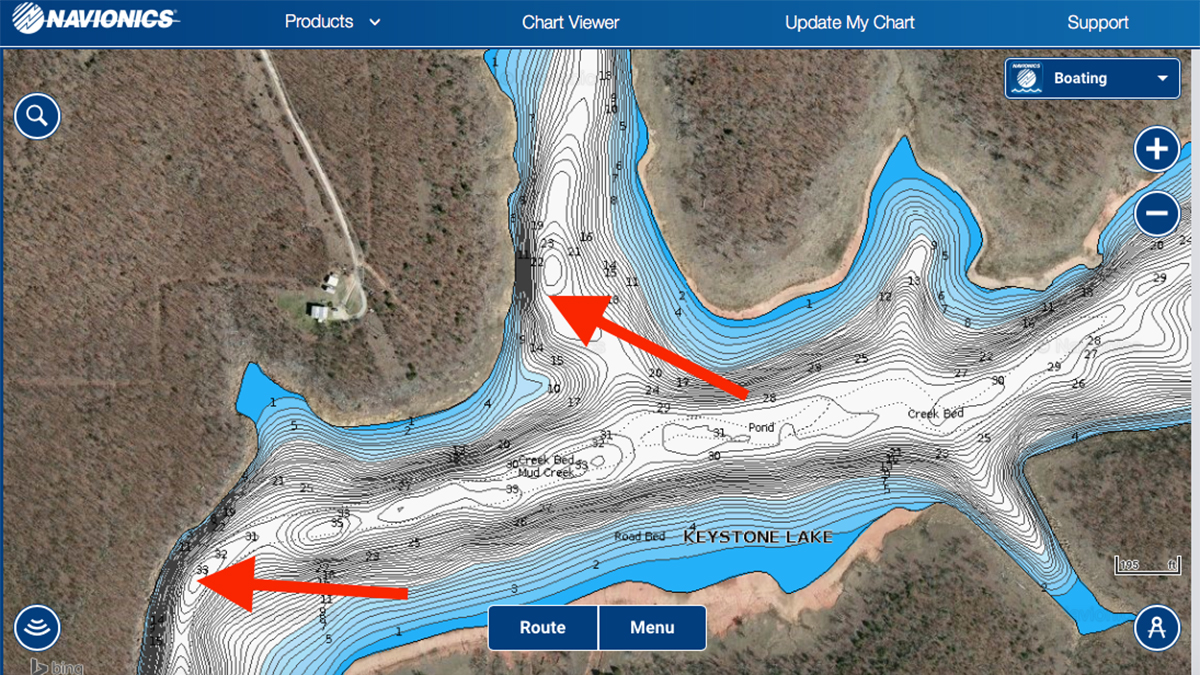
Photo by scout.com/矢印の地点がチャンネルスイングバンク。チャンネルラインの曲がり角が岸に寄っていて、等深線が密集している。
沖のチャンネルスイング/溝
You may read the subheading and think offshore channel swings sound a lot like channel swing banks. And in some ways, you’d be right. An offshore channel swing, or a drain as Lee referred to them, is essentially the same thing as a channel swing bank except it’s happening offshore, 10 to 50 feet below the surface. The same tightly bunched contour lines that identify a channel swing bank reveal potential offshore drains.
“Finding productive drains in the winter can result in some unreal days on the water,” Lee said. “They’re harder to find than channel swing banks but they can often be worth the extra search time. Look for places where a river or creek channel turns next to a flat or long, shallow stretches of water. Not every drain will have bass around it, but when you find one that does you’ll likely have a little off the bank sweet spot all to yourself.”
The depth Lee looks for these drains in changes depending on the fishery, the water clarity and the water temperature. The clearer and colder the water, the deeper Lee explores for productive drains. If faced with cold, dirty water Lee still looks for bass relating to drains but he looks for them in 5 to 10 feet of water as opposed to 20 to 30-foot depths.
“Often times, productive offshore drains or channel swings have natural rock where the river channel meets the shallower water,” Lee explained. “The submerged river channel will have eroded the bottom and churned up rock, wood and other debris which bass live around. Drag a Strike King Tour Grade Finesse Jig through the heaviest cover you can find on a drain or throw a Strike King KVD Deep Jerkbait over top of it. If they are in the area the bass should be unpressured and will be quick to show themselves.”
見出しを読むと、沖のチャンネルスイングと前述のチャンネルスイングバンクでは同じじゃないの、と思うかもしれません。確かにその通りでしょう。沖のチャンネルスイング、または溝は、チャンネルスイングバンクと基本的に同じですが、沖でということを意味するのは、水深が3メートルから15メートルということです。チャンネルスイングバンクを識別したように同じ密集した等深線を沖に見つけたら、隠れている溝を見つけたということです。
「冬に有効的な溝を見つけることで、ボートの上では何かが起きる可能性があります。これはチャンネルスイングバンクよりも見つけるのが難しいのですが、多くの時間を費やしても見つけ出す価値があります。川や支流のチャンネルがフラットの方へ曲がったり、シャローへ伸びている場所を探してください。すべての溝の周りにバスがいるわけではありませんが、もしそれを見つけたら、バンクのスィートスポットから少し離れてみてもいいでしょう。」
リー氏は、そのフィールドや、水の透明度、水温の変化によって適切な深さを探します。水がよりクリアで冷たいほど、リー氏はディープで有効な溝を探します。もし寒気に直面した場合や、荒れた時などでも溝につくバスを探しますが、6~9メートルのディープではなく、1.5~3メートルのレンジで探します。
「多くの場合、チャンネルラインがシャローに寄っている有効な溝やチャンネルスイングには、多くの岩があります。目に見えないチャンネルラインの流れはボトムを洗い流し、岩や木、そして瓦礫が残るため、周囲にバスがつきます。ストライクキング・ツアーグレードフィネスジグをドレンで使ったり、ストライクキング・KVDディープジャークベイトをその上へ投げてみます。バスがそのエリアにいるなら、バスはプレッシャーがかかっていないため、すぐに釣れてくるでしょう。」
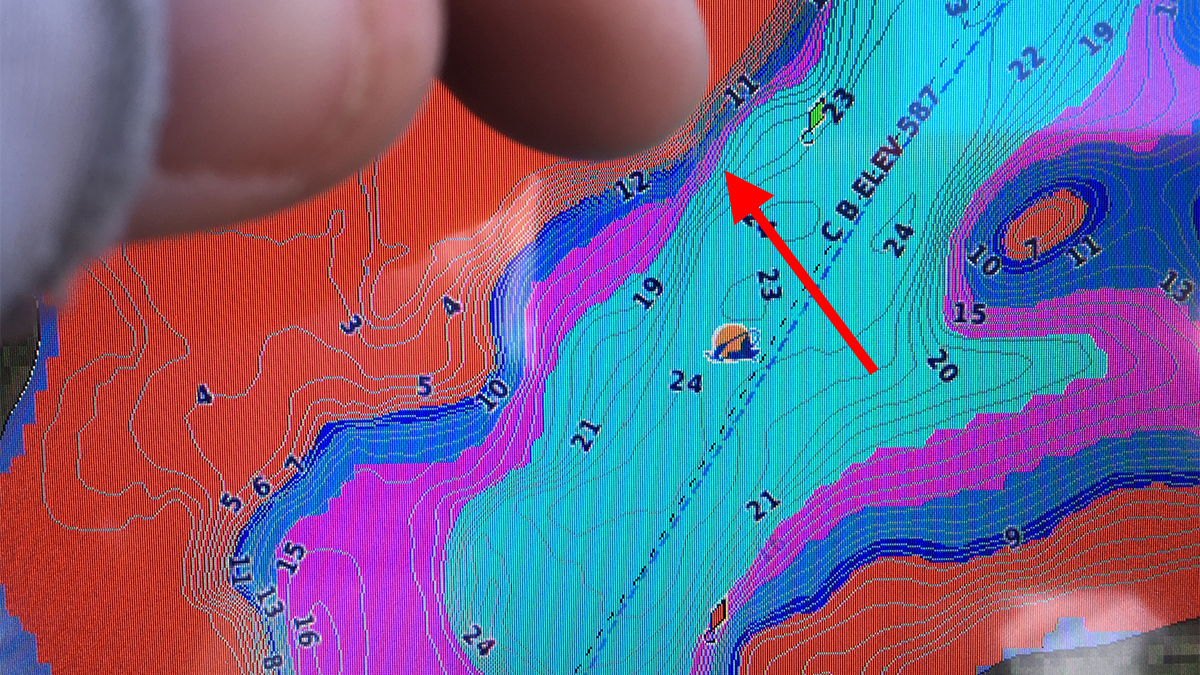
Photo by scout.com/沖まで続く赤いシャローエリアと水色のディープエリアが隣接しているのが分かる。
橋
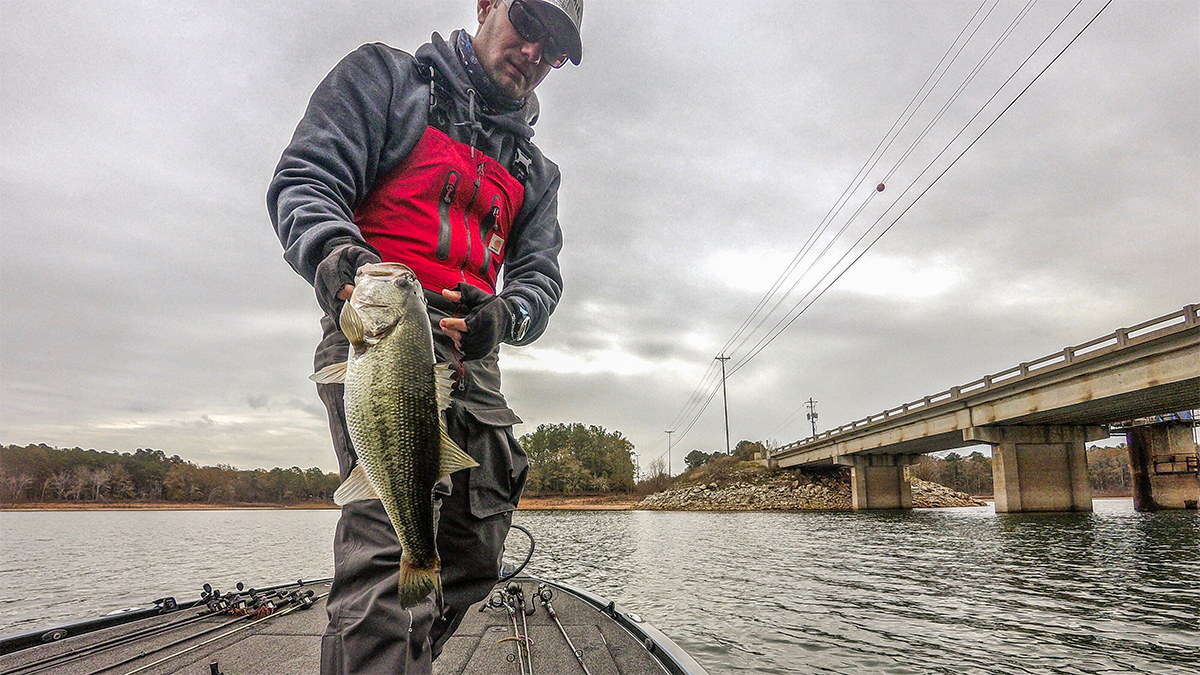
Photo by scout.com
Bridges are Lee’s last hotspot for cold-water bass. It’s no secret that a bridge makes for an excellent place to target bass in frigid water–they typically receive a lot of fishing pressure and for good reason. Bridges are a proverbial one-stop shop for bass throughout the cold-water months. Offering deep water in close proximity to shallow water, an ample amount of baitfish and other forage and a pinch point, which creates natural current or intensifies generated current.
“Even though they’re generally regarded as community holes, don’t avoid bridges in cold water situations,” Lee advised. “A bridge is one of the best places to get a bite no matter what time of year you’re fishing. In the spring, bass move through bridges to head to spawning flats and in the winter, bass move back through bridges migrating to deep wintering holes. So take five to ten minutes and fish through a bridge this time of year. Fishing pressure is curbed in the winter and you could have a bridge beatdown all to yourself.”
While all bridges likely have bass somewhere around them, not all bridges are created equal to Lee when it comes to cold-water scenarios. Experience has taught Lee there are a few key factors that lead to certain bridges being other than others, and he refines his search with these details to give him the best chance for finding feeding bass in cold water.
“I look for bridges in the back half of major creeks arms during the winter months,” Lee said. “A perfect wintertime bridge to me would be towards the back of a major cove (or creek), and it would flatten out or get shallower behind the bridge as you moved towards the back of the cove. Meaning the bridge channel and bridge itself would be the first deep water fish in that creek have available to them, creating a perfect scenario for finding fish migrating out of shallow water for winter. Drag a jig, a shaky head or crank a crawfish-colored Strike King Lucky Shad around and you’ll catch some bass.“
Don’t be overwhelmed with the thought of cold-water bass fishing and don’t spend your time fishing dead water this winter. Follow the insight Matt Lee divulged in this piece and focus your efforts where you’re most likely to be rewarded. Each lake has countless areas you can catch bass when the water cools for winter, but the three Lee lays out above apply to most every fishery and will help you find active bass on your next winter fishing trip.
橋は冷水期のバスを釣るためのリー氏の最後のホットスポットです。冬バスを釣るのに橋が最適な場所ということは別に秘密ではありません。寒い季節の橋はバスのためのコンビニです。ディープとシャローが近くにあり、豊富な量のベイトフィッシュや他のベイトもいて、地形が狭まることで自然と流れが発生するか、流れを強めます。
「そこが非常に人気のある場所だと分かっていたとしても、水が冷たい状況では橋を避けてはいけません。 橋は、あなたが釣っている時期がいつであっても、バイトを得られる最良の場所の一つです。春には、バスは橋を通ってスポーニングエリアに向かい、冬は越冬場所に移動するため橋を通って落ちていきます。ですので、今年は5〜10分かけて橋をくぐってみましょう。フィッシングプレッシャーは冬には抑えられているため、あなた自身への好釣果のまさに橋渡しとなるでしょう。」
すべての橋はそのまわりのどこかにバスがいる可能性がありますが、冷水期に関してはすべての橋が同等ではありません。リー氏の経験によると、その橋が他の橋とは違う特別な橋となる重要な要素がいくつかあり、冷水中でフィーディングしているバスを探す可能性を高めるために、詳細に絞り込んでいきます。
「冬の間はメインリバーの支流の奥のほうにある橋を探しています。 私にとって完璧な冬の橋とは、主要なワンド(または川)の奥にあり、橋を過ぎてワンドの奥に向かって移動するにつれてフラットになるか、浅くなるところです。つまり、橋のチャンネルと橋そのものは、魚にとってその川での最初のディープであり、冬のためにシャローから移動する魚を見つけるための完璧なシナリオを作り出すことを意味します。ラバージグやシェイキーヘッド(ジグヘッド)をズル引きするか、ストライクキング・ラッキーシャドのザリガニカラーを巻いて、バスをキャッチします。」
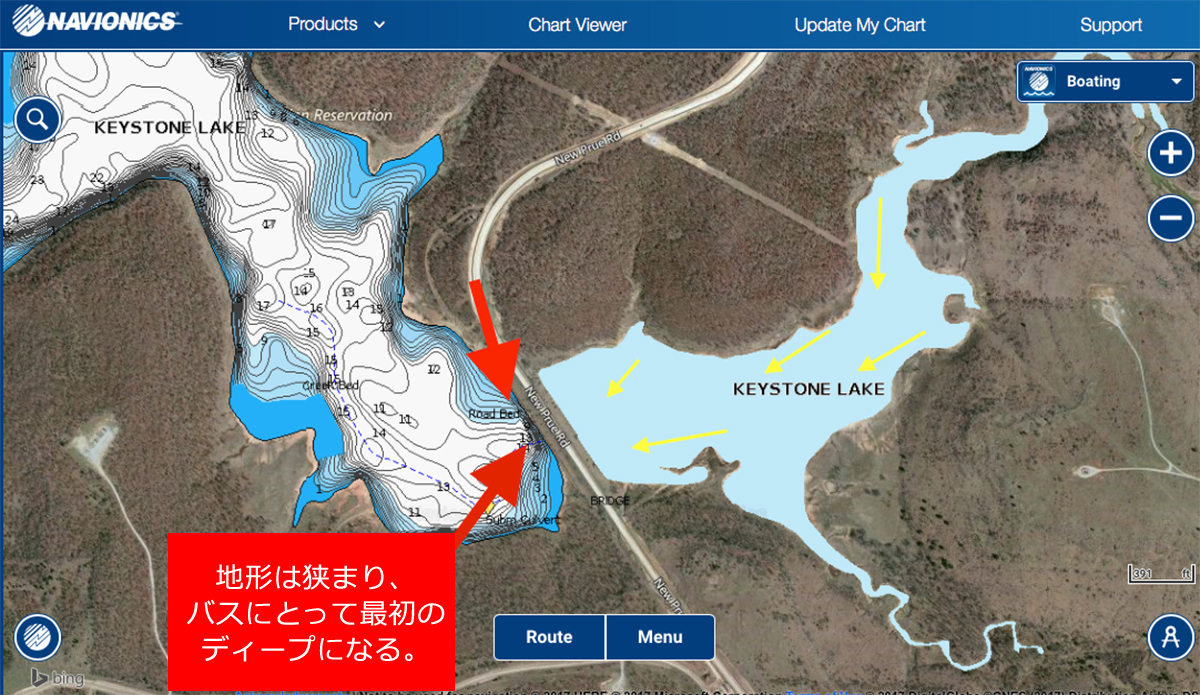
Photo by scout.com
冬のバス釣りに打ちのめされないでください、冬のデッドウォーターで釣りをする時間を過ごさないでください。リー氏がこの記事で解説した内容に従って、リターンを受ける可能性が最も高いところへあなたの努力を集中させてください。それぞれの湖には、冬の水が冷たいときでもバスを捉えることができる無数のエリアがあるのでしょうが、上記の3つのことは、ほとんどすべてのフィールドで適用され、次の冬の釣行でアクティブなバスを見つけるのに役立つはずです。
いかがでしたか。
この話はリザーバーが例に挙げられていますので、普段リザーバーレイクで釣りをされている方にはイメージがしやすいかもしれませんし、リザーバーでやられていない方も、湖流や風の影響を考えてみたら、応用がしやすいのではないでしょうか。ナチュラルレイクでも野池でも、もともとは川がせき止められてできている場合もあるので、意外とチャンネルラインってありますもんね。
ディープが岸に寄っていて、岩やレイダウンが多そうなところ…みなさんのフィールドにはありますでしょうか?
思い当たるスポットがある方は、ぜひこの冬、チャレンジしてみてはいかがでしょうか。
私の場合、ホットスポット探しがうまく行ったとしても、食わせの問題がまだ残っているのですが(笑)。でも、食ってくる確率は上がりそうですから、やっぱり探してみないとですよね。
冬のいいバス、釣ってみたいです。
それでは、また。
毎度ありがとうございます!





